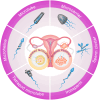Spermbots and Their Applications in Assisted Reproduction: Current Progress and Future Perspectives
- PMID: 38836008
- PMCID: PMC11149708
- DOI: 10.2147/IJN.S465548
Spermbots and Their Applications in Assisted Reproduction: Current Progress and Future Perspectives
Abstract
Sperm quality is declining dramatically during the past decades. Male infertility has been a serious health and social problem. The sperm cell driven biohybrid nanorobot opens a new era for automated and precise assisted reproduction. Therefore, it is urgent and necessary to conduct an updated review and perspective from the viewpoints of the researchers and clinicians in the field of reproductive medicine. In the present review, we first update the current classification, design, control and applications of various spermbots. Then, by a comprehensive summary of the functional features of sperm cells, the journey of sperms to the oocyte, and sperm-related dysfunctions, we provide a systematic guidance to further improve the design of spermbots. Focusing on the translation of spermbots into clinical practice, we point out that the main challenges are biocompatibility, effectiveness, and ethical issues. Considering the special requirements of assisted reproduction, we also propose the three laws for the clinical usage of spermbots: good genetics, gentle operation and no contamination. Finally, a three-step roadmap is proposed to achieve the goal of clinical translation. We believe that spermbot-based treatments can be validated and approved for in vitro clinical usage in the near future. However, multi-center and multi-disciplinary collaborations are needed to further promote the translation of spermbots into in vivo clinical applications.
Keywords: assisted reproduction; biohybrid nanorobot; clinical translation; male infertility; spermbot.
© 2024 Zhang et al.
Conflict of interest statement
The authors report no conflicts of interest in this work.
Figures





Similar articles
-
Spermbots: potential impact for drug delivery and assisted reproductive technologies.Expert Opin Drug Deliv. 2014 Aug;11(8):1125-9. doi: 10.1517/17425247.2014.924502. Epub 2014 May 31. Expert Opin Drug Deliv. 2014. PMID: 24882224
-
Pregnancy outcomes after assisted human reproduction.J Obstet Gynaecol Can. 2014 Jan;36(1):64-83. doi: 10.1016/S1701-2163(15)30685-X. J Obstet Gynaecol Can. 2014. PMID: 24444289
-
Current Insights and Latest Updates in Sperm Motility and Associated Applications in Assisted Reproduction.Reprod Sci. 2022 Jan;29(1):7-25. doi: 10.1007/s43032-020-00408-y. Epub 2020 Dec 7. Reprod Sci. 2022. PMID: 33289064 Free PMC article. Review.
-
Sperm Cell Driven Microrobots-Emerging Opportunities and Challenges for Biologically Inspired Robotic Design.Micromachines (Basel). 2020 Apr 23;11(4):448. doi: 10.3390/mi11040448. Micromachines (Basel). 2020. PMID: 32340402 Free PMC article. Review.
-
The impact of sperm DNA damage in assisted conception and beyond: recent advances in diagnosis and treatment.Reprod Biomed Online. 2013 Oct;27(4):325-37. doi: 10.1016/j.rbmo.2013.06.014. Epub 2013 Jul 11. Reprod Biomed Online. 2013. PMID: 23948450 Review.
Cited by
-
Bioinspired micro- and nanostructured systems for cancer therapy.MedComm (2020). 2024 Nov 28;5(12):e70025. doi: 10.1002/mco2.70025. eCollection 2024 Dec. MedComm (2020). 2024. PMID: 39619230 Free PMC article. Review.
-
Metareview: a survey of active matter reviews.Eur Phys J E Soft Matter. 2025 Mar 4;48(3):12. doi: 10.1140/epje/s10189-024-00466-z. Eur Phys J E Soft Matter. 2025. PMID: 40035927 Free PMC article. Review.
-
Trends and projections of the burden of disease for male infertility in China from 1990 to 2021: an analysis from the Global Burden of Disease 2021 study.Front Reprod Health. 2024 Dec 16;6:1501675. doi: 10.3389/frph.2024.1501675. eCollection 2024. Front Reprod Health. 2024. PMID: 39737093 Free PMC article.
References
Publication types
MeSH terms
LinkOut - more resources
Full Text Sources
Medical
Miscellaneous

